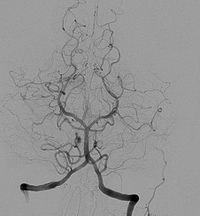
Photo from wikipedia
Digital subtraction angiography (DSA) and optical flow method (OFM) were integrated to quantitate cerebral blood flow in patients with ischemic stroke and the results were utilized to predict the outcome… Click to show full abstract
Digital subtraction angiography (DSA) and optical flow method (OFM) were integrated to quantitate cerebral blood flow in patients with ischemic stroke and the results were utilized to predict the outcome of treatment. A total of 34 patients with ischemic stroke who received endovascular therapy were included in this study. The post-treatment blood flow velocity was significantly higher (P < .001) than the pre-treatment velocity. Anterior–posterior blood flow gain was correlated with National Institute of Health Stroke Scale (NIHSS) score improvement and 90-day mRS. Patients with a higher blood flow gain (> median value of 33.36%) were more likely to have a higher MBD NIHSS improve score (> 4) than those with a lower blood flow gain (< median value). Quantitative digital subtraction angiography provides hemodynamic information for patients treated with endovascular revascularization, and offers a reliable follow-up evaluation for the ischemic stroke treatment.
Journal Title: Journal of Medical and Biological Engineering
Year Published: 2018
Link to full text (if available)
Share on Social Media: Sign Up to like & get
recommendations!